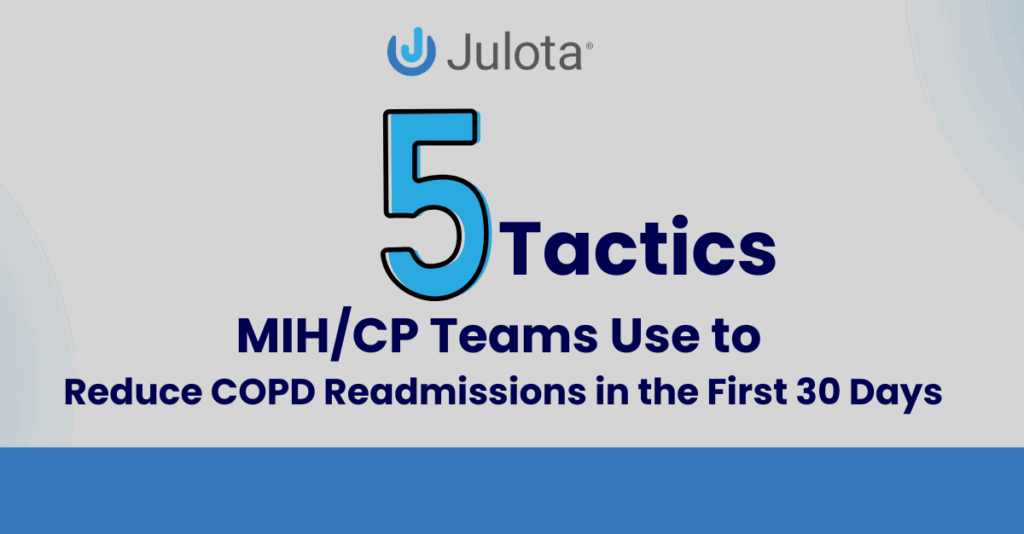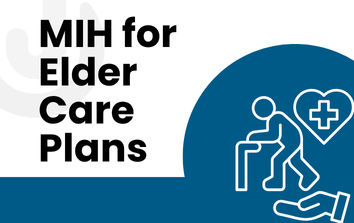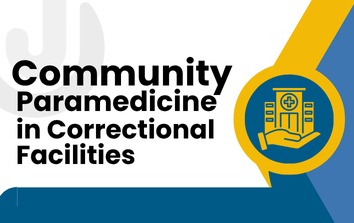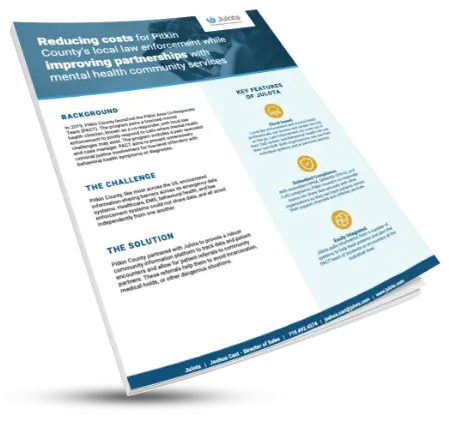COPD readmissions are bad for patients and bad for health systems. In this guide, we’ll talk about five ways MIH-CP can effectively reduce COPD readmissions within a month after hospital discharge.
MIH (Mobile Integrated Health) teams reduce COPD readmissions by following up with patients and assisting them with inhaler regimens, smoking cessation, mobility aids, medication schedules, and out-of-hospital acute care, while ensuring that patients are well-educated on all aspects of their illness.

As we proceed, we’ll provide more context and examples that demonstrate how community paramedic teams help reduce chronic obstructive pulmonary disease (COPD) readmissions.
Five Ways Mobile Integrated Health-Community Paramedicine Works to Reduce COPD Readmissions
Reducing COPD readmissions is crucial because it directly impacts a person’s quality of life. So much so that some insurers penalize hospitals for a high rate of hospital readmissions. The message is simple: we need care that works toward long-term solutions, not just short-term fixes.
The problem? As much as physicians and hospitals work together to reduce COPD readmissions, there has always been a glaring hole in care: the inability to assist the patient directly in the home environment.
This means that a physician can provide the best care to a patient in the hospital, diagnose them perfectly, and prescribe the proper medications to assist them. Still, if the patient goes home and doesn’t follow their treatment plan, it’s almost all for nothing.
That’s where EMS and Mobile Integrated Healthcare-Community Paramedicine (MIH-CP) changes the game. Now, with the advanced training of community paramedics, more care can be delivered to a patient’s home. This allows physicians to better monitor, track, and respond to changes in their patients’ conditions.
But what services exactly can community paramedics deliver in the field? How do they actually work to reduce these hospital readmissions for those struggling with COPD? Let’s talk about it.
Five tactics to reduce COPD readmissions:
- Community paramedics provide education (meds, oxygen, equipment, when to call)
- Mobile integrated health teams assist with inhaler regimens
- MIH teams can be a resource for smoking cessation
- MIH-CP teams can deliver out-of-hospital care
- MIH-CP teams can ensure that people have the mobility aids they need
Note: We are listing five key ways that MIH-CP can help reduce readmissions for COPD; however, community paramedicine is very versatile and can morph to meet the specific needs of a given area. Don’t feel boxed in. Community paramedicine is all about thinking outside the norm in order to reach a proper solution.
Community Paramedics Provide Education
Patient education is an often misunderstood process. Educating a patient does not mean sending them with a pamphlet of confusing information and telling them to read it carefully, nor is it reviewing a PowerPoint presentation with them. While these different aids can be beneficial at times, what patients need is a healthcare provider to walk them through what they need to know to best manage their situation.
For example, if someone with COPD is sent home with a list of instructions, a community paramedic could meet them at their house and walk them through the functional needs of the treatment regimen. This could mean that the community paramedic shows them a good spot to store their medications and gives them the number they need to call to have new meds delivered (if required).
They can also point out hazards and connect people with solutions. For instance, if someone resides in a high-humidity environment, which may compromise their health and make breathing difficult, the community paramedic could connect them with a service that assists in installing central air or area dehumidifiers. This ensures the air they breathe does not compromise their health.
Community paramedics can also assess to ensure that patients know potential triggers to their condition, and that they have some resources to turn to should their condition worsen. This may be because the patient has trouble moving around the bathroom and often becomes short of breath when trying to shower. In this case, the community paramedic can either educate them on an alternative method or connect them with a service that can help install mobility aids.
Finally, community paramedics can educate COPD patients on whom to call and where to go should they become uncomfortable or worried about their condition. In some cases, they will need to call 911 and go to the ER for care; however, there may be instances where they can reach out to the MIH-CP team and receive care in the home, reducing the need for another hospital stay.
Mobile Integrated Health Teams Can Assist with Inhaler Regimens
Another specific way that community paramedics can help patients is by assisting them with inhaler treatment regimens during the first month after discharge from the hospital. How can the community paramedic help?
First, community paramedics can ensure that the patient is completing their treatments regularly. Missing treatments can impact a person’s recovery and ability to cope with COPD.
Second, community paramedics can ensure that patients are performing their treatments correctly. Many people know the general process of taking their treatments, but there are often small nuances (like how they store the medications) that can go overlooked. If a patient isn’t taking their treatments properly, that can negatively impact their recovery and lead to another hospital readmission.
Finally, community paramedics can assess the treatment in real time to ensure it’s working. Some patients respond to certain inhaled medications better than others. If a community paramedic sees that a COPD isn’t responding well to a particular medication, they can let the physician know.
MIH Teams Can be a Resource for Smoking Cessation in Order to Reduce COPD Readmission to Hospitals
Smoking is a leading cause of COPD. When someone with COPD stays in a hospital, they will often receive information on how to stop smoking when they are discharged. In some cases, a patient may have no interest in quitting smoking. In these cases, there is still action MIH-CP can take to reduce danger, such as educating the patient on the risks of smoking around an oxygen tank, avoiding smoking indoors, etc.
However, even for those who do want to quit smoking, following through can be a challenge. For these patients, community paramedics can be there as a kind of accountability, checking in on them and offering some strategies to cope.
Community paramedics can also assist the patient if they have been prescribed any medications to quit smoking. They can ensure that the patient has access to these medications and explain to them the best way to utilize the medication in order to reduce cravings and help them stop smoking.
All these techniques will assist COPD patients in improving their condition and hopefully reducing their risk of being readmitted to the hospital.
MIH-CP Teams Can Deliver Out-of-Hospital Care to Reduce COPD Readmissions
When a patient’s condition deteriorates, they typically require hospital readmission for care. However, with community paramedicine, steps can be taken in the field to reduce the likelihood of hospital readmission.
For example, a community paramedic could work with the physician to try a new medication. Or a patient could receive more regular monitoring from the community professional until their condition is deemed stable.
Be sure to take some time to look at our guide to what community paramedics carry in the field.
Ensuring Patients Have the Mobility Aids They Need
Community Paramedics can also reduce hospital readmissions for COPD patients by ensuring that they have the mobility aids they require. If a COPD patient has to traverse a large set of stairs, has trouble getting up from their chair, or struggles to use the bathroom, they will be more likely to exacerbate their condition and return to the hospital.
The community paramedic can ensure that they have the tools they need to get around their house safely. This involves collaborating with third-party services to ensure the patient has ramps in and out of their home, handrails in their bathrooms, and specialized chairs in their living room if needed.
All of these things cannot be accomplished without the right support. To learn how you can use Julota’s services to help your team combat COPD hospital readmissions, have a look at our advanced software services and find the tools that suit your needs.
Final Words: How Community Paramedicine Reduces COPD Hospital Readmissions
COPD-related hospital readmissions are a serious issue, with many studies dedicated to understanding the problem. Community Paramedics have tactics to combat this issue, and much of it relates to solving that missing element in the care plan: the ability to put boots on the ground in the field.
Community paramedics can educate COPD patients about their condition, provide support for smoking cessation, assist with breathing treatments, and ensure that their environment is conducive to their healing.
Contact Julota to learn more about how their innovative software platform can help your MIH teams combat COPD hospital readmissions and improve the health of your community.




